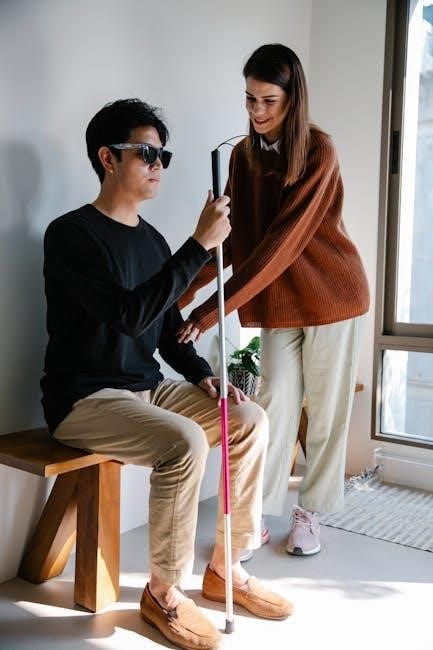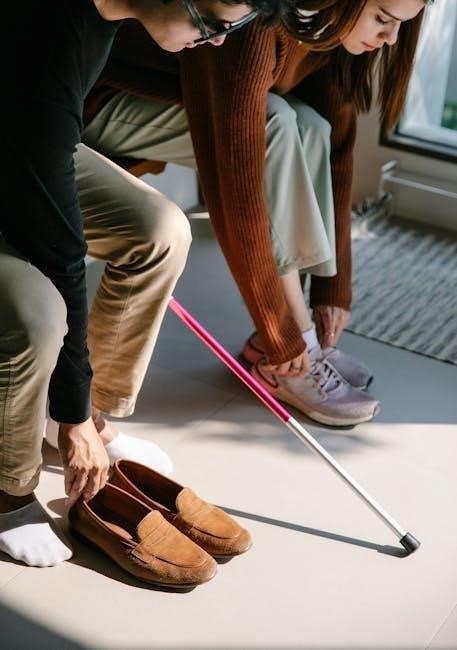A guide stick is a versatile tool used for stability, balance, and support during various activities like hiking, backpacking, or mobility assistance, offering historical and modern utility.
1.1 Definition and Purpose
A guide stick is a handheld tool designed to provide support, balance, and stability during activities like hiking, walking, or mobility assistance. It serves as an extension of the user’s stride, reducing fatigue and enhancing safety on various terrains, while also offering historical and cultural significance in its traditional use.
1.2 Historical Context
Guide sticks trace their origins to ancient times, initially used as simple wooden staffs for support and balance. Indigenous cultures worldwide relied on them for navigation, hunting, and daily tasks, reflecting a deep connection with nature. Their historical significance is marked by traditional designs and symbolic meanings, enduring as practical tools across generations.

Types of Guide Sticks
Guide sticks vary in design and functionality, catering to different needs. They include trekking poles for rugged terrain, walking sticks for casual use, and hiking staffs for added support.
2.1 Trekking Poles
Trekking poles are lightweight, collapsible tools designed for endurance and rough terrain. Made from materials like aluminum or carbon fiber, they offer adjustable lengths and ergonomic grips for comfort. They enhance stability on uneven or slippery surfaces, reduce fatigue by distributing effort, and provide shock absorption for joint relief, making them indispensable for long hikes or backpacking adventures.
2.2 Walking Sticks
Walking sticks are traditional tools designed for casual strolls or urban use, often blending style with functionality. Crafted from wood, aluminum, or other durable materials, they feature ergonomic handles for comfort. Some include decorative elements or accessories like interchangeable tips for versatility. They provide steady support and are ideal for everyday walks or light treks.
2.3 Hiking Staffs
Hiking staffs are sturdy, single-handed tools designed for challenging terrains and long-distance adventures. They often feature adjustable lengths, durable materials, and shock-absorbing tips for better traction. Unlike trekking poles, hiking staffs are typically used with one hand, offering balance and support on uneven paths, while also serving as a reliable companion for off-trail exploration and rugged landscapes.

Benefits of Using a Guide Stick
A guide stick enhances stability, reduces fatigue, and boosts confidence, providing essential support during hikes, treks, or daily walks, while also improving overall safety on various terrains.
3.1 Improved Stability and Balance
A guide stick significantly enhances stability and balance by redistributing weight and providing additional support, especially on uneven or slippery surfaces, reducing the risk of falls and injuries during outdoor activities.
3.2 Reduced Fatigue
Using a guide stick helps minimize fatigue by redistributing weight and providing additional support, allowing users to conserve energy during long walks or hikes, and reducing muscle strain, thereby enhancing overall comfort and endurance.
3.4 Enhanced Safety
A guide stick enhances safety by serving as a protective barrier in crowded areas and providing stability on uneven terrain. It also aids in navigating low-visibility conditions, such as darkness or fog, and can help detect obstacles, ensuring safer movement and increased confidence in challenging environments.
How to Choose the Right Guide Stick
Selecting the right guide stick involves considering material durability, adjustable length, and ergonomic design. Prioritize comfort, weight capacity, and additional features like shock absorption or interchangeable tips for optimal performance.
4.1 Material and Durability
Guide sticks are crafted from durable materials like aluminum, carbon fiber, or wood. Aluminum offers strength and affordability, while carbon fiber is lightweight yet robust. Wooden sticks provide a traditional feel. Durability varies by material, with high-quality options designed to withstand harsh terrains and heavy use; Choose based on activity demands and personal preference for long-lasting reliability.
4.2 Adjustable Length and Ergonomics
Adjustable length is a key feature, allowing customization for different users and terrains. Ergonomic grips and wrist straps enhance comfort and control. Telescoping or folding designs offer versatility, while anti-shock mechanisms reduce impact. Proper fit ensures optimal performance, making guide sticks adaptable to various activities and user preferences for a comfortable, efficient experience.
4.3 Additional Features
Guide sticks may include shock absorption for reduced impact, interchangeable tips for various terrains, and LED lights for visibility. Some models feature GPS, compasses, or whistles for navigation and safety. Durability is enhanced with water-resistant materials, while customizable handles and wrist straps improve comfort. These features cater to diverse needs, ensuring practicality and efficiency in different environments and activities, enhancing overall user experience and functionality.

Maintenance and Care
Regularly inspect and clean your guide stick to prevent dirt buildup. Store it in a dry place to avoid moisture damage. Apply lubricant to moving parts for smooth operation and longevity. Replace worn-out tips promptly to maintain effectiveness. Proper care ensures your guide stick remains reliable and durable over time, enhancing its performance and lifespan through consistent upkeep and attention to detail, guaranteeing optimal functionality in various conditions and activities.
5.1 Cleaning and Storage
Regular cleaning prevents dirt buildup and extends lifespan. Use mild soap and water for metal or wooden parts, and avoid harsh chemicals. Dry thoroughly after cleaning. Store your guide stick in a dry, cool place, away from direct sunlight. Consider using a protective sleeve or bag for storage. Proper care ensures optimal performance and durability.
5.2 Repair and Replacement Tips
Inspect your guide stick regularly for wear or damage. Tighten any loose parts and use epoxy for minor breaks. Replace worn tips or handles promptly to ensure safety and performance. Keep spare parts on hand for quick fixes. For extensive damage, consult a professional or refer to the manufacturer’s guidelines for replacements.
Techniques for Effective Use
Mastering proper posture, grip, and pacing enhances stability. Adjust the guide stick length for comfort and use it rhythmically to maintain balance on diverse terrains for optimal support.
6.1 Proper Posture and Grip
Proper posture involves standing tall with shoulders relaxed and core engaged. Grip the stick with a firm yet comfortable hold, elbows slightly bent. Ensure the stick’s height allows a 90-degree angle at the elbow for optimal support and weight distribution, reducing strain and enhancing comfort during long walks or hikes.
6.2 Pacing and Rhythm
Proper pacing involves synchronizing your walking rhythm with the guide stick’s movement. Maintain a steady, consistent stride, allowing the stick to touch the ground with each step. This rhythm enhances balance, reduces fatigue, and ensures efficient energy use over long distances, making the walking experience smoother and more enjoyable.
6.3 Navigating Different Terrains
When using a guide stick on various terrains, adjust your technique to match the landscape. On flat ground, maintain a steady rhythm, while uphill or downhill, plant the stick ahead for stability. For uneven or rocky paths, use the stick to test footing and balance, ensuring safer traversal and adaptability to diverse environments.

Guide Sticks in Various Activities
Guide sticks are essential in hiking, backpacking, trekking, and mountaineering, offering versatility and support across diverse activities, enhancing stability and endurance for adventurers and mobility-assisted users alike.
7.1 Hiking and Backpacking
Guide sticks are indispensable for hiking and backpacking, offering stability on uneven terrain, reducing fatigue, and enhancing balance. They are particularly useful for long-distance trails or when carrying heavy packs, providing rhythmic support and confidence on challenging paths, with ergonomic grips and adjustable lengths ensuring comfort and versatility for all-day adventures;
7.2 Trekking and Mountaineering
Guide sticks are essential for trekking and mountaineering, providing critical support on rough, steep, or icy terrains. They enhance stability, reduce strain on joints, and aid balance during climbs or descents. Adjustable poles with shock absorption and durable tips are ideal for high-altitude adventures, offering rhythmic support and confidence in challenging, unpredictable environments.
7.4 Mobility Assistance
Guide sticks serve as vital mobility aids for individuals with physical limitations or injuries. They provide balance, stability, and support, reducing fatigue and strain on joints. Adjustable canes or walking sticks are ideal for short-term recovery or long-term use, offering confidence and independence to users navigating daily challenges or recovering from medical conditions.
Psychological and Physical Benefits
Using a guide stick enhances physical endurance, reduces strain on joints, and boosts confidence. It also promotes mental well-being by providing a sense of security and independence during activities.
8.1 Boosting Confidence
A guide stick empowers users by providing stability and control, reducing fear of falls. This sense of security fosters independence, especially in challenging terrains, and enhances overall self-assurance during outdoor activities and daily mobility.
8.2 Improving Physical Fitness
Using a guide stick engages the upper body, enhancing strength and endurance. It promotes better posture, reduces fatigue, and increases calorie burn. Regular use can improve cardiovascular health and muscular tone, making it a valuable tool for overall physical well-being during hiking, trekking, or daily activities.
8.3 Mental Well-being
Using a guide stick can reduce stress and boost confidence, fostering a sense of security and control. The rhythmic motion enhances mindfulness, while overcoming challenges with its aid promotes mental resilience and satisfaction, contributing to overall emotional well-being and a positive outdoor experience.

Guide Sticks in Different Cultures
Guide sticks hold cultural significance worldwide, symbolizing strength, wisdom, and tradition. In indigenous communities, they are used in rituals and storytelling, reflecting deep-rooted heritage and identity.
9.1 Traditional Use in Indigenous Communities
Indigenous cultures worldwide have long utilized guide sticks for navigation, rituals, and storytelling. Crafted from natural materials, they symbolize strength, wisdom, and spiritual connection. Often adorned with meaningful carvings, these sticks are cherished heirlooms, reflecting a community’s history and traditions, and are frequently passed down through generations as symbols of cultural identity and resilience.
9.2 Symbolism and Cultural Significance
Guide sticks hold profound cultural and symbolic meanings across various societies. They represent wisdom, leadership, and spiritual connection, crafted from natural materials like wood. Used in rituals and ceremonies, they symbolize community status and heritage. Their intricate designs reflect cultural stories and values, embodying guidance and support both physically and metaphorically. In many traditions, they serve as a connection to ancestors, representing resilience and continuity, serving as a bridge between past and present.
Modern Innovations
Modern guide sticks feature high-tech materials like carbon fiber for lightweight durability and smart features such as GPS tracking and shock absorption, enhancing functionality and user experience.
10.1 High-Tech Materials
Modern guide sticks utilize advanced materials like carbon fiber and titanium, offering lightweight durability. These high-tech options often feature shock absorption and ergonomic grips, enhancing comfort and stability. Additionally, some sticks incorporate smart features such as GPS tracking and adjustable locks, making them versatile for diverse terrains and weather conditions while maintaining reliability and performance.
10.2 Smart Guide Sticks
Smart guide sticks integrate cutting-edge technology, offering features like GPS tracking, fitness monitoring, and app connectivity. These innovative tools provide real-time data on distance, speed, and calories burned, enhancing both navigation and fitness tracking. Some models include emergency alerts and customizable settings, making them indispensable for tech-savvy adventurers seeking convenience and safety in their outdoor pursuits.

Safety Tips and Precautions
Always use reflective gear for visibility, avoid overreaching, and check surroundings for obstacles. Ensure proper grip and be cautious in wet or uneven terrain for optimal safety.
11.1 Using Guide Sticks in Crowded Areas
When using guide sticks in crowded areas, always be mindful of others. Keep the stick close to avoid accidents, use a retractable tip, and remain polite. Be aware of your surroundings, adjust length for better control, and ensure the stick doesn’t obstruct pathways or pose a hazard to others nearby.
11.2 Safety in Low Visibility Conditions
In low visibility conditions, use a guide stick with reflective tips or LED lights for better awareness. Ensure the stick is sturdy and secure to prevent slipping. Move cautiously, avoid sudden gestures, and stay alert to obstacles. Use the stick to probe the ground ahead, enhancing safety and confidence in dim or foggy environments.
A guide stick is an essential tool offering stability, support, and confidence across various activities, from hiking to mobility assistance, proving its timeless value and versatility.
12.1 Summary of Key Points
A guide stick enhances stability, reduces fatigue, and boosts confidence across activities like hiking, trekking, and mobility assistance. Available in types such as trekking poles and hiking staffs, they offer durability, adjustability, and additional features. Proper techniques, maintenance, and cultural significance highlight their versatility and importance in modern and traditional contexts.
12.2 Final Thoughts on the Importance of Guide Sticks
Guide sticks are timeless tools offering versatility, support, and confidence across various activities. Bridging traditional use and modern innovation, they empower users physically and mentally. Their universal appeal lies in enhancing stability, reducing fatigue, and providing safety, making them indispensable companions for adventurers, travelers, and individuals seeking mobility assistance, ensuring a secure and enjoyable experience.



